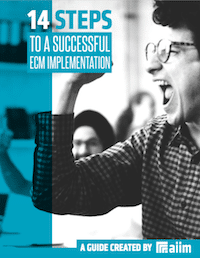The AIIM Blog
Keep your finger on the pulse of Intelligent Information Management with industry news, trends, and best practices.
Enterprise 2.0 | Enterprise Content Management (ECM) | Social Media
I recently blogged on the theme The Cool is Back in ECM, reflecting on my attendance at two widely varying industry events, the Box.Net BoxWorks conference, and IBM's Information on Demand. My conclusion, based on my data point of whether my kids had heard of the entertainment (ECM passed the test this year!), is that the Cool is Back in ECM.
Share
Enterprise Content Management (ECM) | Social Media
What has happened to the old stodgy content management space? One way that I think you can measure the coolness of an industry is to look at who is doing the entertainment at industry functions (I know, frivolous, but stick with me).
Share

Making an ECM implementation successful requires planning and attention to detail. The best way to create the right solution is to identify organizational goals and priorities. Learn how to manage a successful implementation in our free guide.
Capture and Imaging | Document Management | Enterprise Content Management (ECM) | Intelligent Information Management (IIM)
One of the things I talk about during my presentations is that while capture is a mature technology (i.e., it actually works as advertised), the capture market is still relatively immature. Specifically, while a relatively high percentage of user organizations are scanning to archive, relatively few are extracting data from images to doing indexing or metadata, even fewer are extracting data to drive processes, and still fewer have a true enterprise capture strategy.
Share
Enterprise Content Management (ECM)
Industry analysts quote the growth of unstructured content at around 40% a year. A big contributor to content growth is Redundant, Obsolete and Trivial (ROT) files. Still, there are many misconceptions about the concept of ROT.
Share
Enterprise Content Management (ECM)
A few of us were playing around the other night with a new conceptual framework for talking about the lifecycle of ECM. I've attached our back of the napkin thoughts, along with a bit of explanation for the layers. We'd be interested to learn what you think.
Share
Enterprise Content Management (ECM)
Myth #1 – The big ECM software vendors are pushing CMIS. Reality – Back in 2008, Microsoft, IBM, and EMC drafted an initial proposal for an ECM interface specification. This proposed draft specification was shared with Alfresco, Open Text, Oracle, and SAP, later refined by the CMIS TC (Technical Committee), and became an official OASIS standard in May 2010. Now the leading ECM vendors face a difficult situation: the point of no return is passed; now, they have to support the new open standard although they know that the usage of CMIS will weaken their relationship with existing enterprise customers. CMIS helps customers to avoid vendor lock-in and give them independency from a single ECM infrastructure vendor. With CMIS, the ECM repositories will become more and more a commodity, and it will be much harder to successfully monetize a proprietary ECM platform. That’s the reason why the big vendors will not really push the broad and fast adoption of CMIS. They will not spend their marketing-dollars to speed up the necessary customer education. This task has to be done by independent analysts, consultants, ISV’s, and the systems integrators who will see the chance to generate new business based on the upcoming changes in the marketplace.
Share